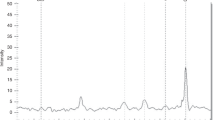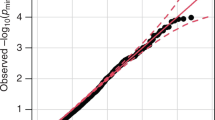Abstract
Bronchopulmonary dysplasia (BPD) is a chronic lung disease that mainly affects premature newborns. Many different factors, increasingly genetic, are involved in the pathogenesis of BPD. The aim of the study is to investigate the possible influence of fibronectin SNP on the occurrence of BPD. The study included 108 infants born between 24 and 32 weeks of gestation. BPD was diagnosed based on the National Institutes of Health Consensus definition. The 5 FN1 gene polymorphisms assessed in the study were the following: rs3796123; rs1968510; rs10202709; rs6725958; and rs35343655. BPD developed in 30 (27.8%) out of the 108 preterm infants. Incidence of BPD was higher in infants with lower APGAR scores and low birthweight. Investigation did not confirm any significant prevalence for BPD development in any genotypes and alleles of FN1. Further studies should be performed to confirm the role of genetic factors in etiology and pathogenesis of BPD.
Similar content being viewed by others
Data availability
The datasets generated during and analyzed during the current study are available from the corresponding author on reasonable request.
References
Jobe AH (2015) Animal models, learning lessons to prevent and treat neonatal chronic lung disease. Front Med 7(2):49. https://doi.org/10.3389/fmed.2015.00049
Xu YP (2016) Bronchopulmonary dysplasia in preterm infants born at less than 32 weeks gestation. Glob Pediatr Health. https://doi.org/10.1177/2333794X16668773
Wadhawan R, Vohr BR, Fanaroff AA, Perritt RL, Duara S, Stoll BJ, Goldberg R, Laptook A, Poole K, Wright LL et al (2003) Does labor influence neonatal and neurodevelopmental outcomes of extremely-low-birth-weight infants who are born by cesarean delivery? Am J Obstet Gynecol 189:501–506. https://doi.org/10.1067/S0002-9378(03)00360-0
Stoll BJ, Hansen NI, Bell EF et al (2010) Neonatal outcomes of extremely preterm infants from the NICHD neonatal research network. Pediatrics 126(3):443–456
Charafeddine L et al (1999) Atypical chronic lung disease patterns in neonates. Pediatrics 103:759–765
Lavoie PM, Pham C, Jang KL (2008) Heritability of bronchopulmonary dysplasia, defined according to the consensus statement of the national institutes of health. Pediatrics 122:479–485. https://doi.org/10.1542/peds.2007-2313
D’Angio CT, Maniscalco WM (2004) Bronchopulmonary dysplasia in preterm infants: pathophysiology and management strategies. Paediatr Drugs 6(5):303–330. https://doi.org/10.2165/00148581-200406050-00004
Pasha AB, Chen XQ, Zhou GP (2018) Bronchopulmonary dysplasia: pathogenesis and treatment. Exp Ther Med 16(6):4315–4321. https://doi.org/10.3892/etm.2018.6780
Colunga Biancatelli RML, Solopov P, Dimitropoulou C, Catravas JD (2021) Age-dependent chronic lung injury and pulmonary fibrosis following single exposure to hydrochloric acid. Int J Mol Sci 22(16):8833. https://doi.org/10.3390/ijms22168833
Henderson B, Nair S, Pallas J, Williams MA (2011) Fibronectin: a multidomain host adhesin targeted by bacterial fibronectin-binding proteins. FEMS Microbiol Rev 35:147–200. https://doi.org/10.1111/j.1574-6976.2010.00243.x
Clemmensen I (1981) Fibronectin and its role in connective tissue diseases. Eur J Clin Invest 11(3):145–146
Hynes RO (1986) Fibronectins. Sci Am 254(6):42–51. https://doi.org/10.1038/scientificamerican0686-42
Fischer HS, Schmölzer GM, Cheung PY, Bührer C (2018) Sustained inflations and avoiding mechanical ventilation to prevent death or bronchopulmonary dysplasia: a meta-analysis. Eur Respir Rev. https://doi.org/10.1183/16000617.0083-2018
Jin R et al (2020) IL-33-induced neutrophil extracellular traps degrade fibronectin in a murine model of bronchopulmonary dysplasia. Cell Death Discov. https://doi.org/10.1038/s41420-020-0267-2
Isayama T, Lee SK, Yang J, Lee D, Daspal S, Dunn M, Shah PS (2017) Revisiting the definition of bronchopulmonary dysplasia. JAMA Pediatr 171:271. https://doi.org/10.1001/jamapediatrics.2016.4141
Avila JJ, Lympany PA, Pantelidis P, Welsh KI, Black CM, Du Bois RM (1999) Fibronectin gene polymorphisms associated with fibrosing alveolitis in systemic sclerosis. Am J Respir Cell Mol Biol 20:106–112. https://doi.org/10.1165/ajrcmb.20.1.3232
Murat M, Aekeper A, Yuan LY, Alim T, Du GJ, Abdusamat A, Wu GW, Aniwer Y (2015) Correlation between the development of calcium oxalate stones and polymorphisms in the fibronectin gene in the Uighur population of the Xinjiang region of China. Genet Mol Res 14:13728–13734. https://doi.org/10.4238/2015.October.28.35
Natarajan G, Shankaran S (2016) Short- and long-term outcomes of moderate and late preterm infants. Am J Perinatol 33:305–317. https://doi.org/10.1055/s-0035-1571150
Thébaud B, Goss KN, Laughon M, Whitsett JA, Abman SH, Steinhorn RH, Aschner JL, Davis PG, McGrath-Morrow SA, Soll RF et al (2019) Bronchopulmonary dysplasia. Nat Rev Dis Prim. https://doi.org/10.1038/s41572-019-0127-7
Kalikkot Thekkeveedu R, Guaman MC, Shivanna B (2017) Bronchopulmonary dysplasia: a review of pathogenesis and pathophysiology. Respir Med 132:170–177
Dani C, Corsini I, Bertini G, Pratesi S, Barp J, Rubaltelli FF (2011) Effect of multiple INSURE procedures in extremely preterm infants. J Matern Fetal Neonatal Med 24(12):1427–1431
Gortner L, Misselwitz B (2011) Rates of bronchopulmonary dysplasia in very preterm neonates in Europe: results from the MOSAIC cohort. Neonatology 99:112–117. https://doi.org/10.1159/000313024
Islam JA, Keller RL, Aschner JL, Hartert TV, Moore PE et al (2015) Understanding the short- and long-term respiratory outcomes of prematurity and bronchopulmonary dysplasia. Am J Respir Crit Care Med 192(2):134–156. https://doi.org/10.1164/rccm.201412-2142PP
Carraro S, Giordano G, Pirillo P, Maretti M, Reniero F, Cogo PE, Perilongo G, Stocchero M, Baraldi E et al (2015) Airway metabolic anomalies in adolescents with bronchopulmonary dysplasia: new insights from the metabolomic approach. J Pediatr 166(2):234–239. https://doi.org/10.1016/j.jpeds.2014.08.049
Korhonen PH, Suursalmi P, Kopeli T, Nieminen R, Lehtimäki L, Luukkaala T, Korppi SA, Moilanen E, Tammela OK et al (2015) Inflammatory activity at school age in very low birth weight bronchopulmonary dysplasia survivors. Pediatr Pulmonol 50(7):683–690. https://doi.org/10.1002/ppul.23038
Shahzad T, Radajewski S, Chao CM, Bellusci S, Ehrhardt H (2016) Pathogenesis of bronchopulmonary dysplasia: when inflammation meets organ development. Mol Cell Pediatr 3(1):23. https://doi.org/10.1186/s40348-016-0051-9
Mao Y, Schwarzbauer JE (2005) Fibronectin fibrillogenesis, a cell-mediated matrix assembly process. Matrix Biol 24:389–399. https://doi.org/10.1016/j.matbio.2005.06.008
Sinkin RA, Roberts M, LoMonaco MB, Sanders RJ, Metlay LA (1998) Fibronectin expression in bronchopulmonary dysplasia. Pediatr Dev Pathol 1:494–502. https://doi.org/10.1007/s100249900068
Mižíková I, Morty RE (2015) The extracellular matrix in bronchopulmonary dysplasia: target and source. Front Med 2:91. https://doi.org/10.3389/fmed.2015.00091
Duan J, Zhang X, Zhang S, Hua S, Feng Z (2017) MiR-206 inhibits FN1 expression and proliferation and promotes apoptosis of rat type II alveolar epithelial cells. Exp Ther Med 13:3203–3208. https://doi.org/10.3892/etm.2017.4430
de Vasconcellos JF, Jackson WM, Dimtchev A, Nesti LJ (2020) A microRNA signature for impaired wound-healing and ectopic bone formation in humans. J Bone Joint Surg Am 102:1891–1899. https://doi.org/10.2106/JBJS.19.00896
Kallapur SG, Pryhuber GS (2015) Bronchopulmonary dysplasia: the search for answers continues. Clin Perinatol 42:xix–xx. https://doi.org/10.1016/j.clp.2015.09.001
Onaran M, Yilmaz A, Şen I, Ergun MA, Çamtosun A, Küpeli B, Menevşe S, Bozkirli I (2009) A HindIII polymorphism of fibronectin gene is associated with nephrolithiasis. Urology 74:1004–1007. https://doi.org/10.1016/j.urology.2009.05.010
Lee CS, Fu H, Baratang N, Rousseau J, Kumra H, Sutton VR, Niceta M, Ciolfi A, Yamamoto G, Bertola D et al (2017) Mutations in fibronectin cause a subtype of spondylometaphyseal dysplasia with “corner fractures.” Am J Hum Genet 101:815–823. https://doi.org/10.1016/j.ajhg.2017.09.019
Yang HY, Su SL, Peng YJ, Wang CC, Lee HS, Salter DM, Lee CH (2014) An intron polymorphism of the fibronectin gene is associated with end-stage knee osteoarthritis in a Han Chinese population: two independent case: control studies. BMC Musculoskelet Disord 15:1–9. https://doi.org/10.1186/1471-2474-15-173
Qin S, Zhang B, Xiao G, Sun X, Li G, Huang G, Gao X, Li X, Wang H, Yang C et al (2016) Fibronectin protects lung cancer cells against docetaxel-induced apoptosis by promoting Src and caspase-8 phosphorylation. Tumor Biol 37:13509–13520. https://doi.org/10.1007/s13277-016-5206-8
Siemianowicz K, Gminski J, Francuz T, Syzdol M, Polanska D, Machalski M, Brulinski K, Magiera-Molendowska H (2001) Fibronectin gene polymorphism in patients with lung cancer. Oncol Rep. https://doi.org/10.3892/or.8.6.1289
Sun Y, Zhao C, Ye Y, Wang Z, He Y, Li Y, Mao H (2020) High expression of fibronectin 1 indicates poor prognosis in gastric cancer. Oncol Lett 19:93–102. https://doi.org/10.3892/ol.2019.11088
Libring S, Shinde A, Chanda MK, Nuru M, George H, Saleh AM, Abdullah A, Kinzer-Ursem TL, Calve S, Wendt MK et al (2020) The dynamic relationship of breast cancer cells and fibroblasts in fibronectin accumulation at primary and metastatic tumor sites. Cancers. https://doi.org/10.3390/cancers12051270
Nakata K, Ujike H, Sakai A, Takaki M, Imamura T, Tanaka Y, Kuroda S (2003) Association study between the fibronectin gene and schizophrenia. Am J Med Genet Neuropsychiatr Genet 116:41–44. https://doi.org/10.1002/ajmg.b.10796
Szpecht D, Al-Saad SR, Karbowski LM, Kosik K, Kurzawińska G, Szymankiewicz M, Drews K, Seremak-Mrozikiewicz A (2020) Role of fibronectin-1 polymorphism genes with the pathogenesis of intraventricular hemorrhage in preterm infants. Child Nerv Syst 36:1729–1736. https://doi.org/10.1007/s00381-020-04598-3
Rezvani M, Wilde J, Vitt P, Mailaparambil B, Grychtol R, Krueger M, Heinzmann A (2013) Association of a FGFR-4 gene polymorphism with bronchopulmonary dysplasia and neonatal respiratory distress. Dis Mark 35:633–640. https://doi.org/10.1155/2013/932356
Weinstein M, Xu X, Ohyama K, Deng CX (1998) FGFR-3 and FGFR-4 function cooperatively to direct alveogenesis in the murine lung. Development 125(18):3615–3623
Floros J, Londono D, Gordon D, Silveyra P, Diangelo SL, Viscardi RM, Worthen GS, Shenberger J, Wang G, Lin Z et al (2012) IL-18R1 and IL-18RAP SNPs may be associated with bronchopulmonary dysplasia in African-American infants. Pediatr Res 71:107–114. https://doi.org/10.1038/pr.2011.14
Winters AH, LeVan TD, Vogel SN, Chesko KL, Pollin TI, Viscardi RM (2013) Single nucleotide polymorphism in toll-like receptor 6 is associated with a decreased risk for ureaplasma respiratory tract colonization and bronchopulmonary dysplasia in preterm infants. Pediatr Infect Dis J 32:898–904. https://doi.org/10.1097/INF.0b013e31828fc693
Yang H, Su S, Peng Y, Wang C, Lee H, Salter D, Lee C (2014) An intron polymorphism of the fibronectin gene is associated with end-stage knee osteoarthritis in a Han Chinese population: two independent case: control studies. BMC Musculoskelet Disord 15(1):173
Murat M, Aekeper A, Yuan L, Alim T, Du G, Abdusamat A et al (2015) Correlation between the development of calcium oxalate stones and polymorphisms in the fibronectin gene in the Uighur population of the Xinjiang region of China. Genet Mol Res 14(4):13728–13734
Untergasser A, Cutcutache I, Koressaar T, Ye J, Faircloth BC, Remm M, Rozen SG (2012) Primer3—new capabilities and interfaces. Nucleic Acids Res 40(15):e115. https://doi.org/10.1093/nar/<br>gks596
Author information
Authors and Affiliations
Contributions
KK and DS designed research; KK, KG, AS, DS, JAA, SRA, and LMK collected and analyzed the data; KK, DS, JAA, AS, SRA, LMK, MS-B, KD, AS-M, and GK performed research; GK was responsible for PCR procedure. All authors commented on the manuscript at all grades.
Corresponding author
Ethics declarations
Conflicts of interest
The authors declare that they have no conflict of interest.
Ethical approval
The study was conducted according to the guidelines of the Declaration of Helsinki, and approved by the Ethics Committee of Poznan University of Medical Sciences (66/14 and 799/16).
Informed consent
Informed consent was obtained from all subjects involved in the study.
Additional information
Publisher's Note
Springer Nature remains neutral with regard to jurisdictional claims in published maps and institutional affiliations.
Supplementary Information
Below is the link to the electronic supplementary material.
Rights and permissions
About this article
Cite this article
Kosik, K., Sowińska, A., Seremak-Mrozikiewicz, A. et al. Polymorphisms of fibronectin-1 (rs3796123; rs1968510; rs10202709; rs6725958; and rs35343655) are not associated with bronchopulmonary dysplasia in preterm infants. Mol Cell Biochem 477, 1645–1652 (2022). https://doi.org/10.1007/s11010-022-04397-1
Received:
Accepted:
Published:
Issue Date:
DOI: https://doi.org/10.1007/s11010-022-04397-1




